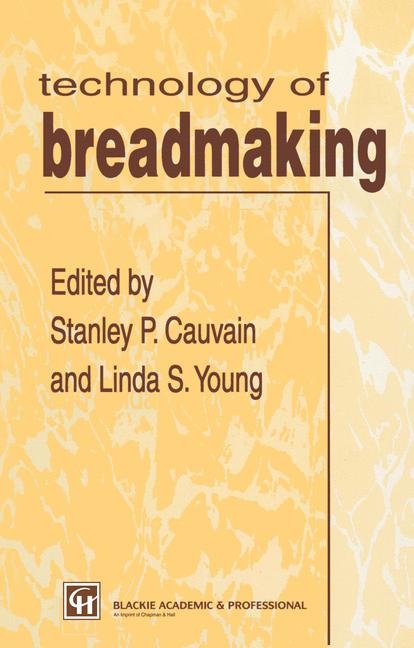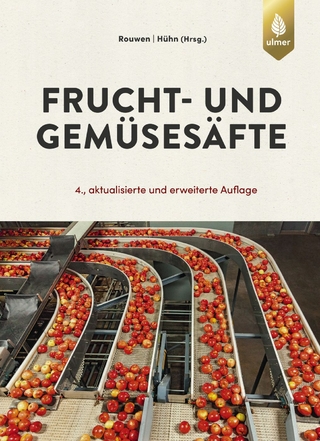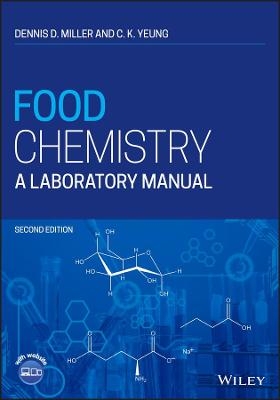
Technology of Breadmaking
Springer-Verlag New York Inc.
978-1-4613-5922-7 (ISBN)
- Titel ist leider vergriffen;
keine Neuauflage - Artikel merken
Wheat is a product of the natural environment, and while breeding and farming practices can modify aspects of wheat quality, we millers and bakers still have to respond to the strong influences of the environment.
1 Bread - the product.- Quality characteristics of bread.- The character of bread.- Bread flavour.- Bread types.- Assessing bread quality.- External character.- Internal character.- Texture/eating quality and flavour.- Nutritional qualities of bread and its consumption.- Conclusions.- References.- 2 Breadmaking processes.- Functions of the breadmaking process.- Cell creation and control.- Major breadmaking process groups.- Straight dough bulk fermentation.- Yeast level.- Flours.- Water levels.- Optional ingredients.- Process variations.- Creation of bubble structure.- Sponge and dough.- Role of the sponge.- Formulations.- Improvers.- Flours and other ingredients.- Process variations.- Rapid processing.- Activated Dough Development (ADD).- No-time doughs with spiral mixers.- The Dutch green dough process.- Role of improvers and other ingredients in rapid processing.- Mechanical dough development.- Chorleywood Bread Process (CBP).- Breadmaking processes, bread variety and bread quality.- References.- 3 Functional ingredients.- Dough conditioners and their composition.- Ingredients.- Fats.- Soya flour.- Additives.- Emulsifiers.- Flour treatment agents.- Preservatives.- Processing aids.- Enzymes.- Alpha-amylases.- Hemicellulases.- Proteinases.- Novel enzyme systems.- Summary of small ingredients.- Bakers' yeast.- Where does yeast come from?.- Principal forms of yeast.- Other yeasts.- Biology of yeast cells.- Overview of commercial yeast production.- Baking with yeast.- Conclusion.- References.- 4 Mixing and dough processing.- Functions of mixing.- Types of mixer.- CBP-compatible mixers.- High-speed and twin-spiral mixers.- Spiral mixers.- Low-speed mixers.- Continuous mixers.- Dough transfer systems.- Dough make-up plant.- Dividing.- Dough damage during dividing.- Two-stage oil suction divider.- Extrusion dividers.- Single-stage vacuum dividers.- Rounding and premoulding.- Types and shapes of rounders.- Conical rounders.- Cylindrical rounders.- Rounding belts.- Reciprocating rounders.- Non-spherical premoulding.- Intermediate or first proving.- Pocket-type prover.- First prover charging methods.- Indexing conveyors.- Pusher in-feed systems.- Pallet in-feed systems.- Discharging.- Conveyorized first provers.- Moulding.- Sheeting action.- Curling.- Final moulding.- Four-piecing.- Cross-grain moulding.- Other sheeting and moulding systems.- Equipment for small bread and rolls.- Small bun divider moulders.- Integrated multi-lane roll plants.- References.- 5 Proving, baking and cooling.- Psychrometry.- Definitions.- The proving process.- Practical proving.- Prover checklist.- Modern prover design.- Airflow.- Ambient conditions.- Mechanical handling.- Developments in proving.- Higher proof temperatures.- Shorter proof time.- Prover to oven.- The baking process.- Crumb structure.- Yeast activity.- Starch gelatinization.- Enzyme activity.- Baked temperature.- Crust formation.- Gloss formation.- Crust crispness.- Oven break.- Practical baking.- Oven design.- Developments in baking.- Oven to cooler.- The cooling process.- Practical cooling.- Cooler design.- Developments in cooling.- Part-baked processes.- Frozen processes.- Ambient processing.- Processing economics.- Weight loss.- Life cycle costs.- References.- 6 Dough retarding and freezing.- Retarding fermented doughs.- Suitability of breadmaking processes.- Recipe and yeast level.- Retarding temperature.- Storage time.- Proving and baking.- Guidelines for retarding dough production.- Retarding pizza doughs.- Freezing fermented doughs.- Breadmaking process, recipe and yeast.- Processing and freezing doughs.- Defrosting and proving.- Freezing proved doughs.- Factors affecting the formation of white spots on retarded and frozen doughs.- Causes of quality losses with retarded and frozen doughs.- Skinning.- Crust fissures.- Ragged crust breaks.- Small volume.- White spots or small blisters.- Waxy patches.- Black spots.- Large blisters.- Dark crust colour.- Uneven or open cell structure.- Areas of dense crumb.- Principles of refrigeration.- Retarder- yeast.- Where does yeast come from?.- Principal forms of yeast.- Other yeasts.- Biology of yeast cells.- Overview of commercial yeast production.- Baking with yeast.- Conclusion.- References.- 4 Mixing and dough processing.- Functions of mixing.- Types of mixer.- CBP-compatible mixers.- High-speed and twin-spiral mixers.- Spiral mixers.- Low-speed mixers.- Continuous mixers.- Dough transfer systems.- Dough make-up plant.- Dividing.- Dough damage during dividing.- Two-stage oil suction divider.- Extrusion dividers.- Single-stage vacuum dividers.- Rounding and premoulding.- Types and shapes of rounders.- Conical rounders.- Cylindrical rounders.- Rounding belts.- Reciprocating rounders.- Non-spherical premoulding.- Intermediate or first proving.- Pocket-type prover.- First prover charging methods.- Indexing conveyors.- Pusher in-feed systems.- Pallet in-feed systems.- Discharging.- Conveyorized first provers.- Moulding.- Sheeting action.- Curling.- Final moulding.- Four-piecing.- Cross-grain moulding.- Other sheeting and moulding systems.- Equipment for small bread and rolls.- Small bun divider moulders.- Integrated multi-lane roll plants.- References.- 5 Proving, baking and cooling.- Psychrometry.- Definitions.- The proving process.- Practical proving.- Prover checklist.- Modern prover design.- Airflow.- Ambient conditions.- Mechanical handling.- Developments in proving.- Higher proof temperatures.- Shorter proof time.- Prover to oven.- The baking process.- Crumb structure.- Yeast activity.- Starch gelatinization.- Enzyme activity.- Baked temperature.- Crust formation.- Gloss formation.- Crust crispness.- Oven break.- Practical baking.- Oven design.- Developments in baking.- Oven to cooler.- The cooling process.- Practical cooling.- Cooler design.- Developments in cooling.- Part-baked processes.- Frozen processes.- Ambient processing.- Processing economics.- Weight loss.- Life cycle costs.- References.- 6 Dough retarding and freezing.- Retarding fermented doughs.- Suitability of breadmaking processes.- Recipe and yeast level.- Retarding temperature.- Storage time.- Proving and baking.- Guidelines for retarding dough production.- Retarding pizza doughs.- Freezing fermented doughs.- Breadmaking process, recipe and yeast.- Processing and freezing doughs.- Defrosting and proving.- Freezing proved doughs.- Factors affecting the formation of white spots on retarded and frozen doughs.- Causes of quality losses with retarded and frozen doughs.- Skinning.- Crust fissures.- Ragged crust breaks.- Small volume.- White spots or small blisters.- Waxy patches.- Black spots.- Large blisters.- Dark crust colour.- Uneven or open cell structure.- Areas of dense crumb.- Principles of refrigeration.- Retarder-provers and retarders.- References.- 7 Application of knowledge-based systems.- Examples of systems for use in bread technology.- Bread Faults Expert System.- Retarding Advisor.- Conclusions.- References.- 8 Baking around the world.- History.- The breadmaking process.- Flour and dough development.- Water.- Yeast.- Salt.- Other improvers.- Dividing.- Resting.- Moulding.- Panning and pans.- Final proof.- Baking.- Cooling.- Slicing and packing.- Packaging.- The international market.- References.- 9 Speciality fermented goods.- Hamburger bun.- Production rates.- Formulation.- Liquid brews and fermentation.- Mixing.- Dough transfer.- Do-flow unit.- Dividing.- AMF Pan-O-Mat.- Flour recovery and pan shaker units.- Proving.- Seed application.- Baking.- Depanning and cooling.- Part-baked breads.- Use of part-baked bread.- Manufacture of part-baked breads.- Baking nets.- Proving and baking.- Depanning and cooling.- Storage of part-baked breads.- Freezing of part-baked bread.- Second and final baking.- Quality of the final product.- The Milton Keynes Process.- Yeasted laminated products.- Formulations.- Ingredients.- Flour protein.- Fat addition to the base dough.- Sugar levels.- Yeast levels.- Laminating or roll-in fat.- Dough mixing.- Methods of adding the roll-in or laminating fat to the dough.- Lamination.- References.- 10 Bread spoilage and staling.- Microbiological spoilage of bread.- Mould spoilage.- Bacterial spoilage.- Yeast spoilage.- Control of microbiological spoilage.- Bread staling.- Crust staling.- Role of the main bread components in crumb staling.- Staling inhibitors.- Enzymes.- Emulsifiers.- Pentosans.- Alcohol.- Sugars and other solutes.- Freezing of bread.- References.- 11 Principles of dough formation.- Flour and dough components.- Starch.- Gluten.- Pentosans.- Lipids.- Water-soluble proteins.- Ash.- Flour components and water absorption.- Wheat gluten proteins.- Amino acid composition.- Gliadin.- Glutenin.- Stages in dough formation.- Hydration.- Blending.- Gluten development.- Breakdown.- Unmixing.- Air incorporation.- The gluten matrix.- Dough rheology.- Gluten structure.- Bonding between protein chains.- Gluten elasticity.- Gluten viscosity.- Extensibility.- References.- 12 Flour milling.- In the beginning.- The modern flour-milling process.- Delivery of the wheat.- Wheat testing.- Wheat storage.- The mill screenroom.- Conditioning.- The mill.- Break system.- Scratch system and bran finishers.- Scalping, grading and dusting.- Purifiers.- Reduction system.- Flour dressing.- Storage and packing.- Food safety and product protection.- Foreign bodies.- Chemical contaminants.- Biological contaminants.- Recent developments in flour milling.- Controlling flour quality and specification.- Grist versus blending.- Additives.- Ascorbic acid.- Enzymes.- Nutritional additions.- Other flour types.- Brown.- Wholemeal (wholewheat).- Self-raising flours.- Malted grain flours.- Flour testing methods.- Protein and moisture content.- Flour grade colour.- Water absorption.- Hagberg Falling number.- Flour rheology.- Farinograph.- Extensograph.- Alveograph.- Use of testing equipment.- Glossary of milling terms used in this chapter.- References.- 13 Other cereals in breadmaking.- Rye bread.- Sour dough methods.- Doughmaking.- Baking.- American rye breads.- Keeping qualities of rye breads.- Triticale.- Other grains and seeds in bread.- Multi-grain breads.- Modifying nutritional properties with non-wheat sources.- Malted barley.- Wheatless breads.- Formation of cake batters.- Bread without wheat.- Unleavened breads.- Recipes for unleavened breads.- Flours for unleavened breads.- Conclusions.- References.
| Zusatzinfo | biography |
|---|---|
| Verlagsort | New York, NY |
| Sprache | englisch |
| Maße | 156 x 244 mm |
| Gewicht | 605 g |
| Einbandart | Paperback |
| Themenwelt | Technik ► Lebensmitteltechnologie |
| ISBN-10 | 1-4613-5922-8 / 1461359228 |
| ISBN-13 | 978-1-4613-5922-7 / 9781461359227 |
| Zustand | Neuware |
| Haben Sie eine Frage zum Produkt? |
aus dem Bereich


